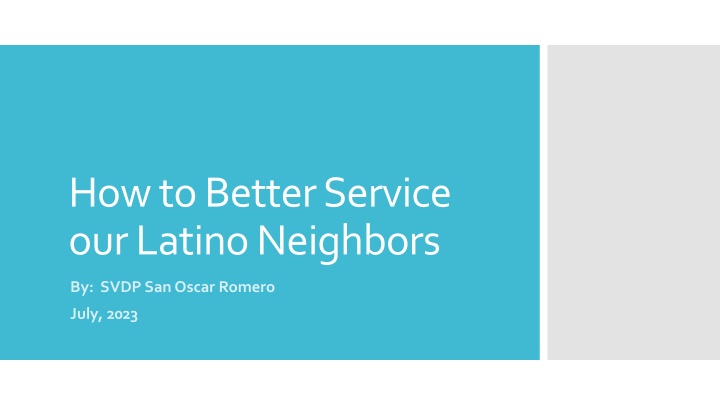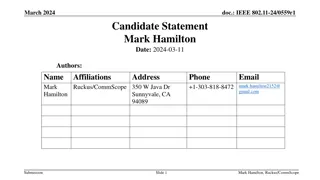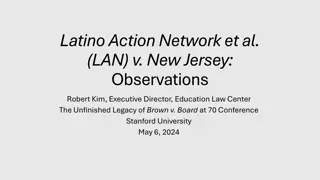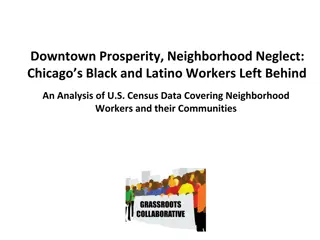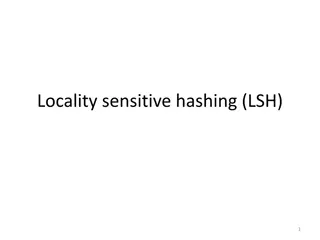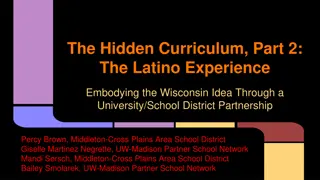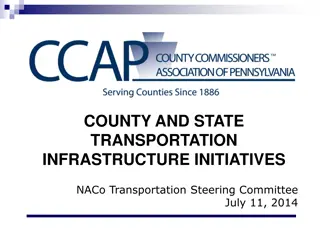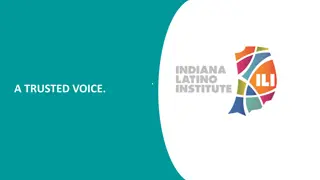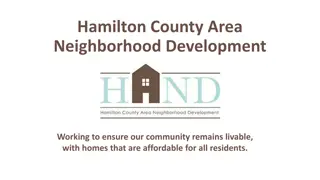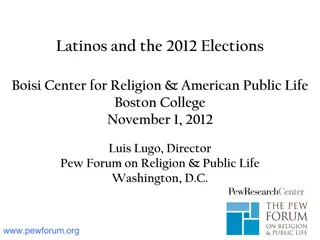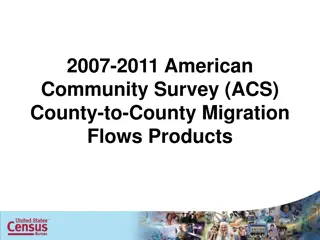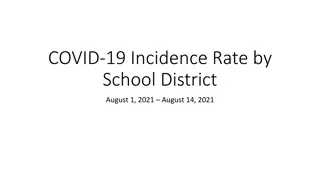Supporting Latino Neighbors in Hamilton County
Ways to support Latino neighbors in Hamilton County, including understanding their backgrounds, challenges, and needs, such as navigating benefits, transportation, and language barriers.
Download Presentation

Please find below an Image/Link to download the presentation.
The content on the website is provided AS IS for your information and personal use only. It may not be sold, licensed, or shared on other websites without obtaining consent from the author.If you encounter any issues during the download, it is possible that the publisher has removed the file from their server.
You are allowed to download the files provided on this website for personal or commercial use, subject to the condition that they are used lawfully. All files are the property of their respective owners.
The content on the website is provided AS IS for your information and personal use only. It may not be sold, licensed, or shared on other websites without obtaining consent from the author.
E N D
Presentation Transcript
How to Better Service our Latino Neighbors By: SVDP San Oscar Romero July, 2023
In Hamilton County, those most in need of assistance are from: Guatemala/Honduras Mexico Honduras Nicaragua What countries do they come from? Venezuela Colombia El Salvador Cuba Puerto Rico (US Territory) They may leave a wife or some children in their home country due to economic reasons and to the dangerous journey. They arrive with debts due to expenses in traveling to the United States. They come here to work in order to support their families. Economic necessity and violence prompts them to leave their home country.
They are: Families with mother and father Singlemothers whose husbands are deported, jailed or abandon the family Who are they? Unaccompanied minors who live with relatives (over 700 are in Hamilton County) Single adults, who often share a place to live Most are undocumented Puerto Ricans are United States citizens
Hamilton County Latinos can be found in all areas of Hamilton County. These are the areas with the highest concentrations. Price-Hill Carthage Springdale Elmwood Place Where do they live? Forest Park Lockland Westwood Winton Place North College Hill Delhi Mt. Healthy Sharonville Many will rent out a room in an apartment or house. This is done to reduce the cost of housing.
As United States citizens, Puerto Ricans qualify for all federal and state benefits. Undocumented Latino immigrants: Cannot get a social security number; In Ohio, they cannot get a driver s license; Do not qualify for federal and state benefits, such as: SNAP benefits, Medicaid or other medical insurance, Section 8 housing, and day care vouchers. Some people use another name in order to work, and this makes it difficult for them to get assistance. For many, it is difficult to file tax returns What benefits do they qualify for? Nicaraguans are eligible for Humanitarian Parole, which means they can get a work permit and qualify for a social security number. There are costs for lawyers and filing the application. U.S. born children between the ages of 14 and 17 can get a work permit.
Transportation They often pay to get rides to work and medical appointments, and are often overcharged. Language Even with interpreters it can be difficult to communicate effectively due to proficiency in Spanish and culture. Proof of Income Benefits that children are eligible for, such as Medicaid and SNAP may be difficult to get due to the fact that many are paid in cash. So, they have no proof of income. Barriers Victims of Crime Latino immigrant workers are sometimes taken advantage of and are not paid for their work. In these cases, there is little they can do. Since it is known that Latino immigrants often carry cash, they are targets for criminals. They need to be encouraged to report these crimes. The police is not interested in their immigration status.
The majority are Catholic, but there are a number of non-Catholic churches with Spanish language congregations. Families are very important, and they tend to have large families. Many Guatemalans speak their indigenous language, and Spanish is their second language. For example, Mum, Awakateko and K iche . Older children raised in the United States are often bilingual, speaking Spanish and English. They could serve as interpreters for their parents. Many immigrants from Mexico and Guatemala come from small, rural areas where they often left school at a young age to work to help support the family. They may be unable to read or write in Spanish. Characteristics The jobs they get are often seasonal, such as working in roofing, landscaping and plant nurseries, outside construction and painting. During the winter months (October through March) they have little or no income. Housekeeping and factory jobs can be year round work. Need to understand that it is important to be on time for appointments, because in their home countries time does not have the same importance.
DIABETES Diabetes is a big problem in the Latino immigrant population. Those with uncontrolled diabetes are often hospitalized, or unable to work. They need referrals to low-income health clinics, as well as the SVDP pharmacy. There is a need for education on healthy eating to help control blood sugar. Existing educational classes should be available in Spanish. (Accessible through Facebook, Instagram and other platforms) Health ALCOHOLISM -- Is a problem in the community Undocumented immigrants can apply for emergency Medicaid benefits in cases of medical emergencies. Clinic and hospital social workers can assist them. DOMESTIC VIOLENCE Needs to be reported to the police CANCER Cancer patients need support with transportation for their treatments, which may take months. Spouse often misses work and have reduced income. Families in this situation need both spiritual and financial support.
Many will rent out a room(s) within their apartment or house to help reduce rent cost. Apartments are often taken over without a new rental lease being signed, so the lease agreement is not under the name of the occupants. Often the house, apartment complex or trailers they rent are old, lack insulation, may lack heating, and are not kept up by the landlord. (Housing Opportunities Made Equal (H.O.M.E.) can assist with landlord issues.) Living Situation Duke Energy bills can be very high because of the poor conditions. They may contact the Community Action Agency (CAA) for assistance in reducing costs. Many Latino immigrants keep the heat on too high and need to be advised to lower the heat and dress warmly. In the summer, they need to be advised to cover windows and not turn on the air conditioning on too low.
U.S. born children receive a social security number and qualify for SNAP benefits and Medicaid medical insurance. Children born in the United States It is important to ask families if they have children born in the United States and ask if they are receiving or have applied for these benefits. If not, then let them know where they can go to apply for the services. They can go to the Su Casa Hispanic Center, Santa Maria, and Jobs and Family Services.
CLOTHING It is important to let people know that the voucher expire and that they need to use it soon. They also need to understand what they can buy with the voucher. They need to be told that they need to pay for anything not covered by the voucher. FURNITURE Latino immigrants move often, and may not have a way to transport furniture from one place to another. They need to be told to take the furniture if they can or donate it. If furniture is left, landlords will throw it away. VOUCHERS BED The process for requesting and obtaining a bed needs to be explained.
It is important to ask Latino immigrant neighbors if the rental contract is under the name of any of the adults in the household. If not, then they do not qualify for CAF. CAF Utility bill must also be under a resident s name, otherwise it does not qualify for CAF. They need to understand that this process takes time. Tell them it could take a few weeks to get the money.
CATHOLIC MASS Holy Family (East Price Hill) Our Lady of the Rosary (Greenhills) St. Ann (Groesbeck) St. Boniface (Northside) St. Clements (St Bernard) St. Leo (North Fairmount) St. Williams (West Price Hill) Churches offering Spanish Language Services OTHER CHRISTIAN SERVICES Iglesia del Nazareno (Carthage)
REFUGEES Come from various countries through the UN refugee camps and Catholic Charities. They have work permits and the ability to become U.S. citizens. U.S. government funds Catholic Charities to assist refugees from Brundi, Bhutan and Afghanistan to find housing and jobs. HUMANITARIAN PAROLE Nicaraguans are usually eligible for Humanitarian Parole, which means they can work in the U.S. by fining an application for a work permit. Cost : usually $500 for a lawyer and $500 to file the application. An Introduction to Immigration ASYLUM Most immigrants who enter the U.S. are eligible to file for asylum. Very few meet the criteria of being persecuted in their home country for political or religious reasons. Cost is from $4,000-$8,000 to file a case Catholic Charities, Immigrant and Refugee Law Center (IRLC) and sometimes Legal Aid charge a minimal amount for asylum cases, but there is a long wait list. U VISA Granted to immigrants who have ben victims of serious crime Can obtain legal status in the U.S. after some years Cost: Catholic Charities, IRLC and Legal Aid do not charge much CANCELLATION/REMOVAL Person is in ICE custody and has a family member (child) with a serious illness, that depends on the person in custody for support. Person has been here for at least 10 years Cost: $1,000
SU CASA HISPANIC CENTER 7162 Reading Road Cincinnati, OH 45237 513-761-1588 Connect to medical, dental, vision and mental health services, benefits applications, ESL classes, summer school program, case management, family reunification, trafficking victims assistance SANTA MARIA COMMUNITY SERVICES 2312 Glenway Cincinnati, OH 45204 513-557-7282 Health education, screenings, eye and hearing exams, mental health support, GED prep, ESL classes, kindergarten readiness, academic tutoring, employment assistance, tax preparation Resources for Latino immigrants HEARTFELT TIDBITS Sheryl Rajbhandari ESL and citizenship classes, facilitate art and sewing classes, community garden, after school tutoring, college preparation, case management, money management, starting a business APOYO LATINO Greater Cincinnati Latino Coalition A website of resources for Latinos as well as events. Focus on social services, health, education and immigration issues. VALLEY INTERFAITH 420 W Wyoming Ave. Cincinnati, OH 45215 513-821-3233 Gives food and clothing to those living in the following zip codes: 45215, 45216, 45217, 45224, 45246, 45237
HOUSING OPPORTUNITIES MADE EQUAL (H.O.M.E.) 24oo Reading Rd., #118 Cincinnati, OH 45202 Assistance with housing discrimination and disputes with landlords COMMUNITY ACTION AGENCY (CAA) 1740 Langdon Farm Rd. Cincinnati, OH 45237 Sergio Mata: 513-512-2641 Assistance to enroll in PIPP payment plant for energy bills. Resources for Latino immigrants WOMEN HELPING WOMEN Crisis intervention, hospital accompaniment, legal advocacy and support groups H.O.M.E. - 513-381-5610 CASA DE PAZ 513-429-5154 Fenix Support Group meets weekly Culturally sensitive temporary home, for women and children who are survivors of domestic violence. Structured programing designed to facilitate transition to independence. CATHOLIC CHARITIES Immigration Legal Services: 513-241-7745 Mental Health Intake: 513-489-8898
